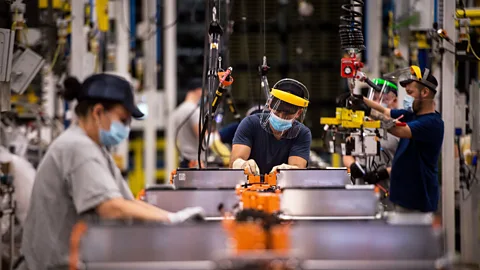Batteries of the future: How cotton and seawater might power our devices
 Alamy
AlamyMining the lithium and other minerals we need for batteries is taking an increasing toll on the environment. There are alternative materials all around us though.
Zip. The power's out. But on a street in India, there's a cash machine still happily dispensing banknotes. Thanks, in part, to burnt cotton. For this cash machine has a backup battery inside it – a battery that contains carbon from carefully combusted cotton.
"The exact process is secret, to be honest with you," says Inketsu Okina, chief intelligence officer at PJP Eye, the Japanese firm that made the battery. He's not joking, either. "The temperature is secret and atmosphere is secret. Pressure is secret," he continues, cagily.
Okina does say that a high temperature is required, above 3,000C (5,432F). And that 1kg (2.2lbs) of cotton yields 200g (7oz) of carbon – with just 2g (0.07oz) needed for each battery cell. The firm bought a shipment of cotton in 2017 and still hasn't used all of it, says Okina.
In the batteries developed by the company, together with researchers at Kyushu University in Fukuoka, Japan, carbon is used for the anode – one of the two electrodes between which flow ions, the charged particles in batteries. Ions move in one direction when the battery is charging and in the other direction when it releases energy to a device. The majority of batteries use graphite as an anode but PJP Eye argues their approach is more sustainable, since they can make anodes using waste cotton from the textile industry.
With huge demand for batteries expected in the coming years, propelled by the rise of electric vehicles and large energy storage systems, some researchers and businesses are frantically developing possible alternatives to the lithium ion and graphite batteries that are commonplace today. Like PJP Eye, they argue we could be using much more sustainable and widely available materials for battery production.
 Getty Images
Getty ImagesAnatomy of a battery
Batteries are formed of three basic components: two electrodes and an electrolyte in between. One of the electrodes becomes positively charged and is known as the cathode, while the negatively charged electrode is the anode. When in use, charged particles called ions flow from the anode to the cathode through the electrolyte. This allows electrons to move through the wires of whatever electrical circuit the battery is connected to.
Lithium mining can have a considerable impact on the environment. Extracting the metal requires large amounts of water and energy, and the process can leave huge scars in the landscape. The recovered lithium is often shipped long distances from where it is mined to be refined in countries such as China. Graphite, too, is mined or made from fossil fuels, both of which also have negative environmental impacts.
"It's very easy to imagine, as a battery material goes through mining and transportation, how that carbon footprint can really add up," says Sam Wilkinson, an analyst at S&P Global Commodity Insights.
To take another example: cobalt, which is used in many lithium-ion batteries, is predominantly extracted in the Democratic Republic of Congo. But there have been reports of dangerous working conditions there.
From seawater to biowaste and natural pigments, there is a long list of potential alternatives in nature that would be much more widely available – the hard part is proving that any of them can realistically compete with the kinds of batteries already on the market, which are seemingly so indispensable in our gadget-strewn world.
PJP Eye also touts the possibility of improving battery performance as well as making batteries greener. "Our carbon has a bigger surface area than graphite," says Okina, describing how the chemistry of the anode in their Cambrian single carbon battery allows for a battery that charges very quickly, up to 10 times faster than existing lithium ion batteries, he claims.
The battery's cathode is made from a "base metal" oxide. Although Okina won't disclose exactly which one, these metals include copper, lead, nickel and zinc, which are more readily and less reactive than alkaline metals such as lithium. The company claims to be working on a dual carbon electrode battery, where both electrodes are made from plant-based carbon. The technology is based on research conducted by researchers at Kyushu University, although the battery is not expected to be available until 2025.
Being able to charge a battery quickly doesn't matter too much for a cash machine, but it does for an electric vehicle when you just want to juice it up and go. He mentions that the Chinese firm Goccia, in partnership with Hitachi, has developed an e-bike that uses PJP Eye's battery and will put it on sale in Japan early in 2023. The bike's maximum speed is 50km/h (31mph) and you can travel a distance of 70km (44 miles) on one charge, he says.
It's far from the only battery that uses carbon from waste biomaterials. Stora Enso in Finland has developed a battery anode that uses carbon from lignin, a binding polymer found in trees.
Cotton could also be used in place of the electrolyte that facilitates the flow of ions between the cathode and anode, potentially creating more stable, solid-state batteries than those currently available, according to some researchers.
